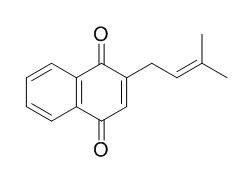Deoxylapachol
Deoxylapachol has anti-wood rot activity, it can inhibit the brown rot fungi Gloeophyllum sepiarium CBS 353.74 and Gloeophyllum trabeum CBS 318.50 and the white rot fungi Merulius tremellosus CBS 280.73 and Phlebia brevispora CBS 509.92. It also can induce fungal cell wall stress.
Inquire / Order:
manager@chemfaces.com
Technical Inquiries:
service@chemfaces.com
Tel:
+86-27-84237783
Fax:
+86-27-84254680
Address:
1 Building, No. 83, CheCheng Rd., Wuhan Economic and Technological Development Zone, Wuhan, Hubei 430056, PRC
Providing storage is as stated on the product vial and the vial is kept tightly sealed, the product can be stored for up to
24 months(2-8C).
Wherever possible, you should prepare and use solutions on the same day. However, if you need to make up stock solutions in advance, we recommend that you store the solution as aliquots in tightly sealed vials at -20C. Generally, these will be useable for up to two weeks. Before use, and prior to opening the vial we recommend that you allow your product to equilibrate to room temperature for at least 1 hour.
Need more advice on solubility, usage and handling? Please email to: service@chemfaces.com
The packaging of the product may have turned upside down during transportation, resulting in the natural compounds adhering to the neck or cap of the vial. take the vial out of its packaging and gently shake to let the compounds fall to the bottom of the vial. for liquid products, centrifuge at 200-500 RPM to gather the liquid at the bottom of the vial. try to avoid loss or contamination during handling.
J. Pharm. Biomed. Anal.2024, 245:116193.
J Appl Microbiol.2024, 135(7):lxae180.
Eur J Pharmacol.2018, 832:96-103
Kor. J. Pharmacogn.2016, 47(1):62-72
Biotechnol Bioeng.2020, 117(7):2198-2208.
Universidade Estadual Paulista2017, 11449
J Med Food.2024, 27(8):728-739.
J Ginseng Res.2022, 46(1):104-114.
Int J Mol Sci.2020, 21(7):2530.
Analytical sci. & Tech2016, 186-193
Related and Featured Products
Planta Med. 2006 Aug;72(10):943-4.
Activity of quinones from teak (Tectona grandis) on fungal cell wall stress.[Pubmed:
16972200]
METHODS AND RESULTS:
Teak ( Tectona grandis L.f., Verbenaceae) sawdust extract inhibited the growth of Aspergillus niger. Centrifugal partition chromatography was used to isolate the active compounds. By (1)H-NMR the active compounds were identified as Deoxylapachol and tectoquinone. Two A. niger transgenic strains which show induction of 1,3 -alpha-D-glucan synthase were used as a cell wall damage model.
CONCLUSIONS:
The result showed that Deoxylapachol from T. grandis extract induced fungal cell wall stress.
J. Wood Chem.Technol.,2008, 28(4):247- 60.
Identification of Anti-Wood Rot Compounds in Teak (Tectona grandis L.f.) Sawdust Extract.[Reference:
WebLink]
METHODS AND RESULTS:
The tropical hardwood sawdust of Tectona grandis L.f. from the wood processing industry was extracted and tested for anti-wood rot activity. Tectona grandis extract inhibited the brown rot fungi Gloeophyllum sepiarium, Gloeophyllum trabeum, Piptoporus betulinus and Serpula lacrymans, and the white rot fungi Bjerkandera adusta, Merulius tremellosus, and Phlebia brevispora. Centrifugal partition chromatography was used to separate these compounds using n-hexane-MeOH-H2O (50:47.5:2.5) as a solvent system. The compounds Deoxylapachol, tectoquinone, 2-hydroxymethylanthraquinone, 3′-OH-deoxyisolapachol (2-[(1E)-3-hydroxy-3-methylbut-1-enyl]naphthoquinone), hemitectol (2,2-dimethyl-2H-benzo[h]chromen-6-ol), and tectol were isolated from Tectona grandis sawdust CHCl3-MeOH (1:1) extract.
CONCLUSIONS:
Deoxylapachol inhibited the brown rot fungi Gloeophyllum sepiarium CBS 353.74 and Gloeophyllum trabeum CBS 318.50 and the white rot fungi Merulius tremellosus CBS 280.73 and Phlebia brevispora CBS 509.92. Hemitectol together with tectol showed a high percentage of cellulase inhibition followed by 3′-OH-deoxyisolapachol and Deoxylapachol.



